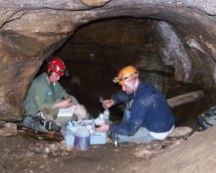Fluid Pathway Delineation in Karst Aquifers
Research Info
Student: Andrew Francis
Advisor: Eric Peterson
In karst terrain, ground water is especially vulnerable to contamination from land-use activities because of the direct and rapid hydrologic link between surface water and ground water. When impacted surface water enters swallet or storm-water runoff flows into a sinkhole, contaminants enter the ground water directly. The direct connection to the ground water eliminates the possibility of soil filtration, degradation, and sorption of the contaminant.
Karst aquifers are vulnerable to surface water impact. Assessing the risks to a karst system requires knowledge of the sources as well as the pathways the water flows. Unlike traditional porous media aquifers, karst systems are complex due to flow along bedding planes, fractures, and conduits. Understanding the flow with karst aquifers is an important step in preserving the integrity of the system, including the biological habitat.
Andrew's work focuses on fluviokarst systems, specifically where there is contact between carbonate and non-carbonate rocks. Carbonate rocks weather by chemical and physical processes, while non-carbonate rocks weather primarily by physical processes. The difference in weathering processes between carbonate and non-carbonate rocks should influence the landscape development as a whole. For this project, we are looking to determine whether lithology is a controlling factor in the landscape evolution of fluviokarst systems. One example of a fluviokarst system is located in Carter Caves State Resort Park, northeastern Kentucky. This area has 25m of limestone bounded by siliciclastic units. To evaluate the difference in erosion between limestone and siliciclastic bedrock streams, longitudinal profiles will be created and analyzed. The erosive forces of streams will be determined by calculating stream power values. Approximately 30 stream profiles will be analyzed to allow for a statistical analysis. A t-test will be performed to determine the statistical relationship between the lithologies. A statistically significant relationship between stream power values of limestone and siliciclastic streams would indicate that the development of this fluviokarst system is controlled by lithology.

Recent karst related publications include:
- Schroeder, K.*, Peterson, E.W., and Dogwiler, T., 2015, Field validation of DEM and GIS derived longitudinal stream profiles, Journal of Earth Science Research (JESR), v. 3, no. 3, p. 43-54, doi: 10.18005/JESR0303002
- Woodside, J.*, Peterson, E. W., and Dogwiler, T., 2015, Longitudinal profile and sediment mobility as geomorphic tools to interpret the history of a fluviokarst stream system: International Journal of Speleology, v. 44, no. 2, doi: 10.5038/1827-806X.44.2.9
- Angel, J.C.*, and Peterson, E.W., 2015, Nitrates in karst systems: comparing impacted systems to a relatively unimpacted system: Journal of Geography-Geology, v. 7, no. 1, doi 10.5539/jgg.v7n1p56
- Doucette, R.*, and Peterson, E., 2014, Identifying water sources in a karst aquifer using thermal signatures: Environmental Earth Sciences, p. 1-12, doi:10.1007/s12665-014-3387-2.
- Jacoby B.S.*, Peterson E.W., Kostelnick JC, Dogwiler T, 2013, Approaching Cave Level Identification with GIS: A Case Study of Carter Caves. ISRN Geology, v. 2013, no. 160397, pgs. 7, DOI:10.1155/2013/160397
- Jacoby, B.S.*, Peterson, E.W., Dogwiler, T., and Kostelnick, J.C., 2011, Estimating the timing of Cave Level Development with GIS: Speleogenesis and Evolution of Karst Aquifers, v. 11, 52-61
- Jacoby, B.S.*, Peterson, E.W., and Dogwiler, T., 2011, Identifying the Stream Erosion Potential of Cave Levels in Carter Cave State Resort Park, Kentucky, USA: Journal of Geographic Information Systems, v. 3, no. 4, p. 323-333, DOI:10.4236/jgis.2011.34030.